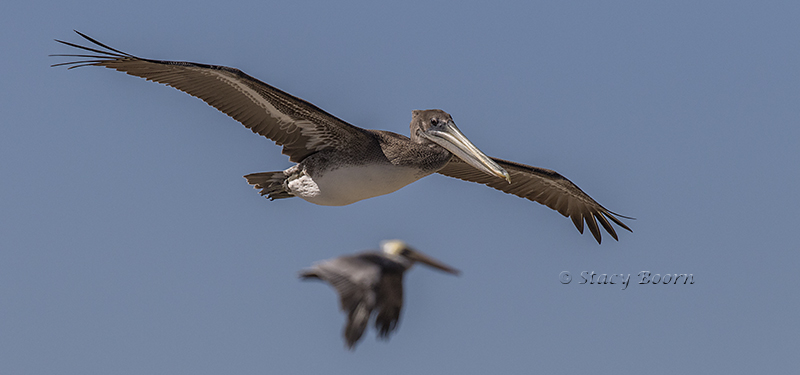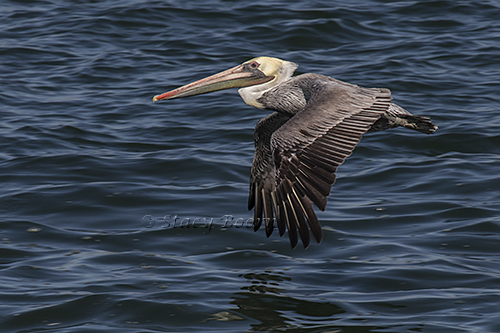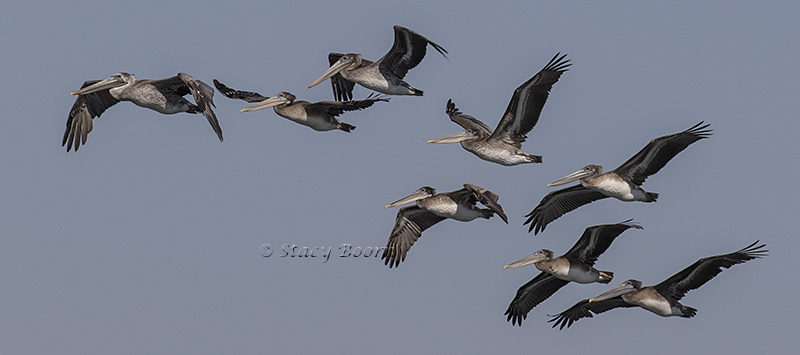Perhaps it’s because of their looks, a combination of the homely and comedic, that one expects pelicans to be more clumsy than charming. But it isn’t so! If you stand on one of our beaches and look out at the ocean, especially in fall and winter, you see pelicans flying low in lines, gliding just above the waves. When at rest, they often love to perch on docks and railings in fishing harbors and wharves as if they were part of the daily flock of visitors.
 In the 1960s and ’70s, the Brown Pelican became a rare sight along the U.S. coastlines. The pelican decline was the result of the use of pesticides such as DDT which caused pelican eggshells to thin beyond the shells’ ability to hold and incubate their offspring. With the banning of DDT, the Brown Pelican populations have recovered.
In the 1960s and ’70s, the Brown Pelican became a rare sight along the U.S. coastlines. The pelican decline was the result of the use of pesticides such as DDT which caused pelican eggshells to thin beyond the shells’ ability to hold and incubate their offspring. With the banning of DDT, the Brown Pelican populations have recovered.
Long before I learned that pelicans were a symbol of the Divine Feminine and the Mother Jesus of the medieval church, I loved them. Their wings seemed be the bridge between the heavens and the earth as they turned gracefully to descend to the waters or beaches below.
 In the Middle Ages, Saint Gertrude of Helfta had a vision of Christ as a pelican. Inspired by Psalm 102, the church interpreted the female pelican as a symbol of Christ, believing this magnificent bird was able to give her life-restoring blood to her dead offspring. This metaphor was based on a popular fallacy, yet the imagery of the mother pelican returning to her brood to restore them to life continues to spark my spiritual imagination.
In the Middle Ages, Saint Gertrude of Helfta had a vision of Christ as a pelican. Inspired by Psalm 102, the church interpreted the female pelican as a symbol of Christ, believing this magnificent bird was able to give her life-restoring blood to her dead offspring. This metaphor was based on a popular fallacy, yet the imagery of the mother pelican returning to her brood to restore them to life continues to spark my spiritual imagination.
It has been more than 25 years since Virginia Ramey Mollenkott reclaimed the biblical imagery of God as female. Of the pelican she has written, “The dream that the male pelican kills its offspring, while the female pelican bestows new life upon them, turns out to presage a reality for many of us in the contemporary faith community.â€
 She continues: “Exclusively male images of God are killing our spirit by distorting our understanding of masculinity, femininity, and mutuality. The recognition of biblical images of God as female, the infusion of positive female images into the language of faith, the achievement of balance between male and female references, will do a lot to bring us renewed health.†The Divine Feminine, page 47.
She continues: “Exclusively male images of God are killing our spirit by distorting our understanding of masculinity, femininity, and mutuality. The recognition of biblical images of God as female, the infusion of positive female images into the language of faith, the achievement of balance between male and female references, will do a lot to bring us renewed health.†The Divine Feminine, page 47.
Watching the brown pelicans gliding, flying, landing, diving and taking off along the California coastal beaches is a spiritual activity worth returning to on a regular basis. Even if the imagery of the divine feminine is not a part of your vision, the pelicans’ incredible grace offers you soul-renewing energy. For me, and perhaps for you, tracking and photographing them in flight is both a challenge and discipline to be pursued religiously!
 I love the Brown Pelican’s feathers! Like all other birds, their feathers define them and are unique to each. As the Brown Pelican matures its plumage will change. In addition, its plumage changes from season to season. No other animal has feathers. The feather itself is a complex product of the bird’s skin, and its structure is one of nature’s greatest wonders. “My heart in hiding stirred for a bird, — the achieve of, the mastery of the thing!†– Gerard Manley Hopkins (1844-1889), English poet.
I love the Brown Pelican’s feathers! Like all other birds, their feathers define them and are unique to each. As the Brown Pelican matures its plumage will change. In addition, its plumage changes from season to season. No other animal has feathers. The feather itself is a complex product of the bird’s skin, and its structure is one of nature’s greatest wonders. “My heart in hiding stirred for a bird, — the achieve of, the mastery of the thing!†– Gerard Manley Hopkins (1844-1889), English poet.
